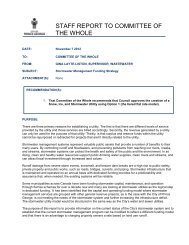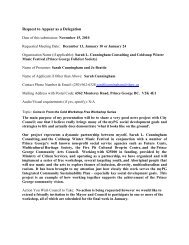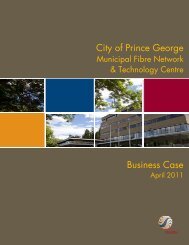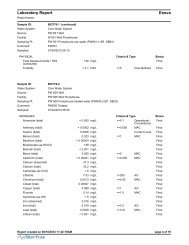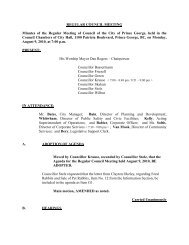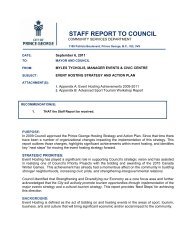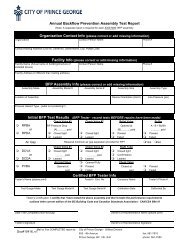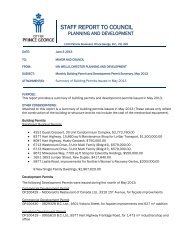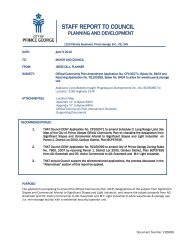Blackburn Wastewater Treatment Plant Upgrade Study
Blackburn Wastewater Treatment Plant Upgrade Study
Blackburn Wastewater Treatment Plant Upgrade Study
You also want an ePaper? Increase the reach of your titles
YUMPU automatically turns print PDFs into web optimized ePapers that Google loves.
SECTION 3.0<br />
AUDIT OF EXISTING FACILITIES<br />
3.1 BLACKBURN WASTEWATER TREATMENT PLANT<br />
The <strong>Blackburn</strong> WWTP is adjacent to Foreman Road and treats wastewater<br />
from the Prince George Airport, Airport Hill, Aitcheson and Blackbum areas.<br />
The plant was constructed in 1976 for a design population of 2,500, and<br />
consists of an inlet works, two aerated lagoons with coarse bubble aeration,<br />
and a chlorination facility. h e plant is presently close to both its design<br />
hydraulic and organic loading capacity. Its hydraulic capacity is often<br />
exceeded during wet weather and winterkpring thaw conditions, which<br />
contribute high levels of III to the wastewater flows. Emuent quality is also<br />
impacted during the spring to summer transition as the lagoons warm up.<br />
Lagoon temperatures in the winter are in the order of 0°C to 5"C, and in the<br />
summer they can exceed 20°C.<br />
At the time of the site visit in September 1999, the lagoon system was<br />
producing an emuent quality of BOD5 < 15 mgiL and TSS < 5 mgL. On<br />
average, the lagoon emuent BODj/TSS concentrations are approximately<br />
20120 mgL, with occasional pmit exceedences during high flows in the<br />
spring. During high flow periods, the plant also regularly exceeds the<br />
maximum allowable daily flow stipulated in the discharge permit.<br />
There are also a number of reported operating problems with the plant. These<br />
include the "freezing" of inlet control valves to the lagoons due to corrosion,<br />
and odour generation during the late spring and early summer. The nearest<br />
houses are approximately 100 m away korn the lagoons. Occasional odour<br />
complaints are received, particularly during the spring breakup when the<br />
lagoon temperature increases, anaerobic biological activity increases and rising<br />
sludge is observed. The operators address the problem by pumping sludge<br />
from the primary lagoon to the secondary lagoon over a 6 week period during<br />
this time.<br />
3.1.2 Preliminary <strong>Treatment</strong><br />
The existing screening room has three influent channels: two 600 mm wide<br />
channels (one equipped with a 75 mm trash rack, one bypass) and a central 450




